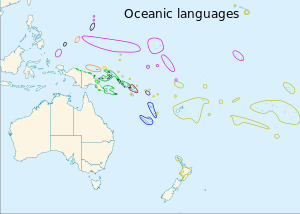Oceanic languages
| Oceanic | |
|---|---|
| Geographic distribution: |
Melanesia, Micronesia, Polynesia |
| Linguistic classification: |
Austronesian
|
| Proto-language: | Proto-Oceanic |
| Subdivisions: | |
| Glottolog: | ocea1241 |

The branches of Oceanic
The black ovals at the northwestern limit of Micronesia are the Sunda–Sulawesi languages called Palauan and Chamorro. The black circles in with the green are offshore Papuan languages.
|
|
The approximately 450 Oceanic languages are a well-established family of Austronesian languages. The area occupied by speakers of these languages includes Polynesia, as well as much of Melanesia and Micronesia.
Though covering a vast area, Oceanic languages are spoken by only two million people. The largest individual Oceanic languages are Eastern Fijian with over 600,000 speakers, and Samoan with an estimated 400,000 speakers. The Kiribati (Gilbertese), Tongan, Tahitian, Māori, Western Fijian and Kuanua (Tolai) languages each have over 100,000 speakers.
The common ancestor which is reconstructed for this group of languages is called Proto-Oceanic (abbr. POc).
The Oceanic languages were first shown to be a language family by Sidney Herbert Ray in 1896 and, besides Malayo-Polynesian, they are the only established large branch of Austronesian languages. Grammatically, they have been strongly influenced by the Papuan languages of northern New Guinea, but they retain a remarkably large amount of Austronesian vocabulary.
According to Lynch, Ross, & Crowley (2002), Oceanic languages often form linkages with each other. Linkages are formed when languages emerged historically from an earlier dialect continuum. The linguistic innovations shared by adjacent languages define a chain of intersecting subgroups (a linkage), for which no distinct proto-language can be reconstructed.
...
Wikipedia
